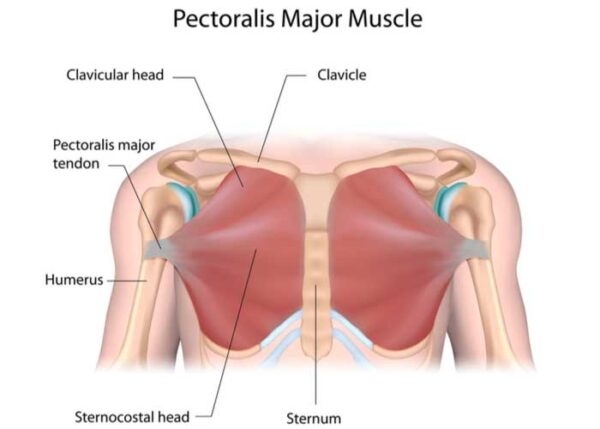Pectoralis Major Tendon Repair Surgeon

A pectoralis major tendon injury occurs when the tendon is pulled away from its attachment site on the humerus (upper arm bone). Pectoralis major tears are often seen among individuals involved in weight-lifting and labor-intensive work. While a partially torn tendon or a tendon strain can be treated conservatively, completely torn pectoralis major tendons require surgery. Pectoral tendon surgeon, Doctor Riley J. Williams provides diagnosis as well as surgical and nonsurgical treatment options for patients in Manhattan, Brooklyn, New York City and surrounding areas who have sustained a pectoralis major tendon injury. Contact Dr. Williams’ team today!
What is a pectoralis major tendon injury?
Located on the anterior (front) chest wall are two large, fan-shaped muscles. These muscles are part of the pectoral major complex and are also known as the “pecs”. The pectoralis major muscle originates from the center of the sternum (chest) and clavicle (collarbone). The muscle travels along the chest wall where it ultimately anchors to the humerus (upper arm bone) by means of the pectoralis major tendon. The pectoralis minor muscle originates from the third, fourth, and fifth ribs and attaches to the coracoid process of the scapula (shoulder blade). These muscles work in concert to provide strength and stability to the shoulder when lifting or pushing heavy objects. A pectoralis major tendon injury occurs when the tendon is pulled away from its attachment site on the humerus. Pectoralis major tears are often seen among individuals involved in weight-lifting and labor-intensive work. This type of injury results when the force applied to the pectoralis major muscle exceeds the strength of the pectoralis major tendon’s attachment to the humeral bone. A partial tendon tear may only affect the sternal head of the pectoralis major tendon, whereas a complete tendon tear involves both the sternal head and the clavicular head of the pectoralis major.

What is the treatment for a pectoralis major tendon injury?
A pectoralis major tendon strain, partial tendon tear, or muscle strain/tear can generally be treated conservatively. Patients are encouraged to decrease or avoid activities that initially caused the injury or exacerbate the pain. A combination of rest, ice, and non-steroidal anti-inflammatory medications (NSAIDs) is also recommended for pain management.
Most pectoralis major tendon injuries will require surgery to repair the tendon. Surgical intervention is the most reliably successful method for repairing a pectoralis major tendon injury. Surgical repair of the tendon involves reattaching the tendon to its the correct anatomical position on the humerus. The goal of surgically repairing a pectoralis major tendon injury is to restore stability and strength to the shoulder. A chronically torn pectoralis tendon is a debilitating condition. Dr. Riley J. Williams, orthopedic shoulder doctor, treats patients in Manhattan, Brooklyn, New York City, NY and surrounding areas, who have experienced a pectoralis major tendon injury and need a surgical repair.
How is a pectoralis major tendon repair performed?
Pectoralis major tendon repair requires a small incision near the native insertion of the tendon on the humerus. Prior to the procedure, the patient is placed under light sedation and regional anesthesia is administered. A small incision is made over the anterior shoulder. The dissection localized and identifies the torn tendon edge. After removing the devitalized tissue on the lateral margin of the torn tendon, it then reattached to the humerus using strong sutures and anchors that are placed within the humeral bone.
Patients who present with a chronically torn pectoralis major tendon may experience shortening or scarring. In these circumstances, a tendon graft, either from the patient (autograft) or a donor (allograft), may be necessary to facilitate the proper reattachment of the tendon to the humeral shaft. This tendon graft is then sewn into the native pectoralis major muscle prior to bony reattachment. To prevent pectoralis major tendon retraction and scarring, patients who have experienced a pectoralis major tendon tear are strongly encouraged to seek immediate medical attention as these can make for a difficult surgical repair.
What is the recovery period like after a pectoralis major tendon repair?
The recovery period following a pectoralis major tendon repair is dependent on the injury severity and chronicity. Most patients can expect a return to normal daily activities in approximately 6 weeks. A full recovery, including sports, typically takes 4-6 months. In general, patients in New York can expect the following:
- Immobilization of the shoulder joint, with a sling or other device, immediately following surgery and remain immobilized for 2 weeks.
- A combination of rest, ice, and non-steroidal anti-inflammatory medications (NSAIDs) will be used to control pain and decrease inflammation. Dr. Williams may prescribe stronger pain medication to be taken as directed.
- Active participation and completion of the physical rehabilitation program detailed by Dr. Williams is the key to a successful recovery. Passive and active shoulder exercises are carefully performed with the help of the physical therapy team to re-establish shoulder strength, mobility, and range of motion. Formal PT starts one week after surgery and continue for approximately 3 months.
For more information on pectoralis major tendon repair, or to discuss your pectoralis major tendon treatment options, please contact the office of Riley J. Williams, MD, orthopedic shoulder doctor at the Hospital for Special Surgery (HSS), serving Manhattan, Brooklyn, New York City, NY and surrounding areas.